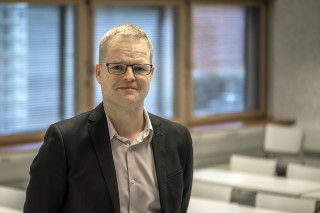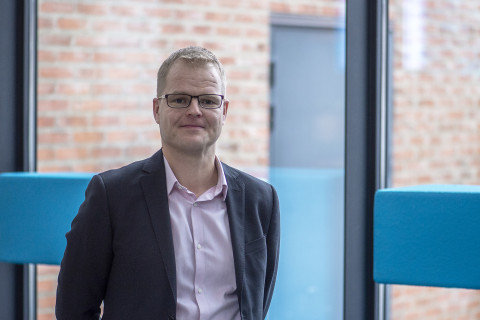“Instead of planning for growth, regions with a dwindling population should learn to adapt to shrinkage,” says Teemu Makkonen, UEF’s newly appointed Professor of Regional Research and Economic Geography.
Planning in regions with a shrinking and ageing population requires a radical change in thinking. Traditionally, even small municipalities have drawn up major plans and strategies for growth, but now, they should plan to adapt their services to the needs of a shrinking population. This change is often a painful one.
“The paradigm of regional planning has always been growth-oriented. When minds are set on growth, it is difficult to switch gears and start planning for shrinkage. Often, municipal office holders and politicians understand the need for downscaling, but it is difficult for politicians to say it out loud,” the University of Eastern Finland’s newly appointed Professor of Regional Research and Economic Geography Teemu Makkonen says.
Makkonen has seen well-prepared municipal strategies, as well as those that are based on wishful thinking. Wishes are often translated into slogans where municipalities advertise themselves as the “capital of this” or the “hub of that”. Palace-like municipal halls, too, create an image of growth. Fewer municipalities bravely state in their strategy that they no longer aim for growth.
“The battle of a small entity should be based on realism. For example, why build a big and expensive new school for a municipal centre and close down smaller schools, if the municipal centre will not have enough children in ten years’ time? Wouldn’t it simply make more sense to keep the smaller schools running?” Makkonen asks.
Makkonen leads the Adaptive and Innovative Countryside research project, and he also works as a researcher in the What Does Smart Shrinking Mean in Finland? project. Both address the same issue, i.e., smart adaptation of shrinking and ageing populations and regions.
“Both projects deal with the same question, that is, why do areas with shrinking populations actually thrive on many indicators? Municipalities have done some interesting and innovative experiments on what they, as organisations, can do. In Pyhtää, for example, the municipal hall was sold, at a very fair price, to companies providing cultural services. There, it was understood that the task of a municipality is not to own real estate. Cultural services, on the other hand, bring vitality to the municipality.”
Although shrinking as a phenomenon is global, it has a unique regional context. You can't generalise too much.
Teemu Makkonen
Professor of Regional Research and Economic Geography

Business Finland funding has created regional growth during the COVID-19 pandemic
Teemu Makkonen took up the permanent post of Professor of Regional Research and Economic Geography at the University of Eastern Finland on 1 November 2021. He works at the Karelian Institute on the Joensuu Campus. The professorship also involves teaching at the Department of Geographical and Historical Studies.
“In a nutshell, I study why some regions thrive and others don’t. Then, we try to find ways to make things better. Economic geography examines the success of regions from the perspective of economics. The perspective of regional research is broader, and the development of a region is also examined using methods of human geography and physical geography,” Makkonen says, describing his field.
Regional research starts from an understanding that small entities have distinctive characteristics and their own purpose, which cannot be described on the level of a state, for example. On the level of Finland, there are great differences between Helsinki and Ilomantsi. Taking into account the special characteristics of regions is important in policy recommendations.
“Shrinking is different in an urban suburb and in a rural village. Although shrinking as a phenomenon is global, it has a unique regional context. You can't generalise too much. If a policy recommendation prepared by researchers is too general, it may not be suitable for anyone. At the extremes, at least, it won’t be helpful.”
Makkonen obtained his PhD in economic geography from the University of Helsinki in 2012, and his doctoral dissertation dealt with the geography of innovations. The theme is also present in the Business Finland funded project Effects of Subsidized Collaboration on Spatial Innovation Capacity, CoSPIN, where Makkonen leads a work package.
“Economic growth comes from innovations, and all economic development can be defined as innovations. The purpose of the CoSPIN project is to analyse how funding for innovations brings economic growth to regions. During the COVID-19 pandemic, Business Finland has allocated a lot of funding for development, and the sensibility of this funding has been called into question. Forecasting models show that it was a smart move, one that is very clearly linked to economic growth in the regions,” Makkonen says.
“Innovations arise from sufficient diversity”
Teemu Makkonen was born in North Karelia, eastern Finland, which explains his research interest in cross-border interaction.
“The Soviet Union sounded very scary to me when I was a kid. However, when doing business with the Russians as an adult, things weren’t so scary anymore. Cross-border interaction and trade should especially be seen as a resource,” Makkonen emphasises.
Makkonen also dismantles the idea of narrowly defined regions and borders. According to him, regions nowadays form a “network of streams”.
“What kind of streams cross the border? Is the border something that prevents things from happening, or something that makes them possible? I see the border as something that makes things possible, like in North Karelia, where it is a source of trade.”
Sufficient diversity is also useful – there’s nothing to learn when things are completely similar.
“Some degree of integration is needed in cross-border trade in terms of legislation, but innovations arise from sufficient diversity,” Makkonen points out.
Teemu Makkonen
- Professor in Regional Research and Economic Geography, University of Eastern Finland, 1.11.2021–
- Doctor of Philosophy, University of Helsinki, 2012.
- Docent, Cross-border Economic Development, University of Eastern Finland, 2019.
- Docent, Economic Geography, University of Helsinki, 2015.
Key roles
- Professor, Karelian Institute, University of Eastern Finland, 2019–2021.
- Research Director, Karelian Institute, University of Eastern Finland, 2018–2019.
- Postdoctoral Research Fellow, Institute for Advanced Social Research, University of Tampere, 2016–2018.
- Marie Curie Research Fellow, School of Hospitality and Tourism and Management, University of Surrey, UK, 2014–2016.
- Assistant Professor, Department of Border Region Studies, University of Southern Denmark, 2014.
A print-quality photo of Teemu Makkonen is available for download at: https://mediabank.uef.fi/A/UEF+Media+Bank/44536?encoding=UTF-8




